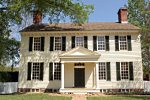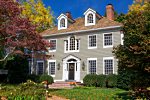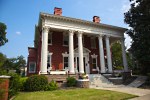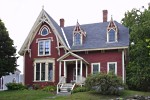Restoring Your Home to the Original Historic Paint Colors
If you live in a historic home, your house has probably been painted several times over the years. The current paint job probably bears no resemblance to it’s original color scheme. In many communities, there are tax credits available to help restore old buildings to their former glory. These incentives can cover up to 45% of the total bill, so it’s worth looking into!
Another reason to consider restoring your home with historical paint colors is individuality. Because so few of these historic buildings exist, it’s unlikely that returning it to it’s former color scheme will turn your home into a cookie cutter dwelling. In fact, a departure from today’s earth tones can be a refreshing change that will revitalize the whole block!
How Do I Choose Historic Colors?
Your historical society can help you determine an appropriate color scheme. The year it was built and the style of the structure can yield important clues. These societies have spent hours of research to determine which colors were typical in a given era; take advantage of hard work and extensive knowledge!
If you suspect your home may not have been “typical” for the era in which it was built (it belonged to an eccentric millionaire or artist, for example), paint samples can provide a more accurate picture.
Heritage consultants take paint samples from several areas of your home, analyze them in a lab, and provide a list of the closest matches in today’s modern paints. Their experience helps them adjust for fading, soil, and multiple layers of paint and choose remarkably accurate substitutes. Hiring a consultant also protects you from exposure to lead paint, which was used on most buildings prior to 1978.
If you prefer to do the work yourself, the “bull’s eye method” can help you determine, fairly accurately, what colors were used in the original construction of your home. You’ll need to assess the siding, the trim, and doors and shutters- depending on the style of your house, you may find that three or four different colors were used.
Samples should be from shaded, well-protected areas of the house, where fading will be minimal. If possible, choose areas that would have been easier to paint over than to scrape clean; this increases the likelihood that one of the the bottom layers is the original color.
Sand the paint in a four-inch circle. This will expose every layer of paint. Keep in mind that the very bottom layer may not be paint; instead, it may be primer or a basecoat. Check with your historical society if the hue surprises you; they can help you determine if it was the exterior color or part of the prep work.
Remember to wear a respirator and take all the precautions for removing lead-based paint.
Common Color Schemes for Historic Homes
It probably comes as no surprise that different architectural styles look best with different paint. You may find that the original color your home was painted isn’t your cup of tea: in that case, you can still restore a historic look by using color schemes common to that style and era. Just be aware that you may not qualify for tax credits if you change it up.
Colonial Homes
 True Colonials are found in New England, but reproductions of this popular styles are also common along the Gulf coast, and in Southwest. These homes are one or two stories and have identical windows on each side.
True Colonials are found in New England, but reproductions of this popular styles are also common along the Gulf coast, and in Southwest. These homes are one or two stories and have identical windows on each side.
Earthy colors are the rule here: umber, ochre, indigo, and red were popular.
Colonial Revivals
 This style was popular in new construction from 1900 to 1940. Features included multi-pane windows, gabled roofs, and classical details, like columns and moldings.
This style was popular in new construction from 1900 to 1940. Features included multi-pane windows, gabled roofs, and classical details, like columns and moldings.
Blue, brown, and gray were popular colors on these buildings.
Federal or Adams-style
 These homes are usually found in port cities. This architectural style was popular from 1780 to 1830. Features include fan shaped, circular, or elliptical windows; low or flat roofs with balustrades; shutters; and arches.
These homes are usually found in port cities. This architectural style was popular from 1780 to 1830. Features include fan shaped, circular, or elliptical windows; low or flat roofs with balustrades; shutters; and arches.
Soft blue, sage green, pumpkin, and neutral cream colors were popular here; these homes often had brick facades, so color was usually limited to trim, shutters, and doors.
Greek or Neo Classical Homes
 Typical of Southern mansions, these stately buildings often include columns and look distinctly classical. They were generally painted white, both out of tradition and to reflect the sun in hot climates.
Typical of Southern mansions, these stately buildings often include columns and look distinctly classical. They were generally painted white, both out of tradition and to reflect the sun in hot climates.
Victorian Homes
 These elaborate houses are reminiscent of a gingerbread house. They often have castle-like turrets and towers, elaborate, lacy trim, and patterned shingles. It’s not uncommon for a Victorian home to have four or five different colors on the exterior.
These elaborate houses are reminiscent of a gingerbread house. They often have castle-like turrets and towers, elaborate, lacy trim, and patterned shingles. It’s not uncommon for a Victorian home to have four or five different colors on the exterior.
Favorites were a gingery yellow, mulberry, and moss green.
Be aware that, although today’s formulas are far more durable than older versions, certain colors wear better than others. Fading, staining, and other discoloration are inevitable when sun, snow, and wind are involved, but these effects can be minimized by understanding how exterior paint color influences performance.
You may find that a complete restoration includes replacing shingles as well as paint. Stained shake shingles were popular on many types of homes, and many colors of asphalt shingles were used- not just black!
Are Historic Colors the Only Choice?
If you’ve done the research and decided that historic paint colors just aren’t your cup of tea, there’s no reason to despair. Your decor, both interior and exterior, should be a reflection of your personal tastes. After all, you’re the one living there! Feel free to use all historical colors, all modern colors, or a mixture of the two- no one will look down on you if you choose to depart from the original.


